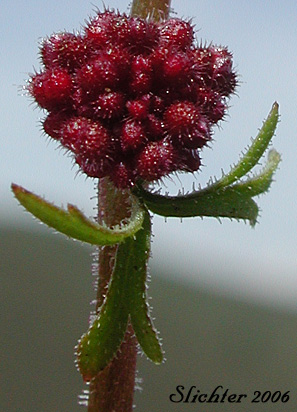 The photo at right shows a close-up of a cluster of vegetative bulbils
in the axil of a stem leaf on bulblet prairie star. Photographed atop the Columbia
Hills in the eastern Columbia River Gorge..........May 1, 2005.
The photo at right shows a close-up of a cluster of vegetative bulbils
in the axil of a stem leaf on bulblet prairie star. Photographed atop the Columbia
Hills in the eastern Columbia River Gorge..........May 1, 2005.
The USDA has recently renamed this species to Lithophragma glabrum.
Also known as rock star or fringecup, bulblet prairie star is an attractive perennial with stems arising 10-20 cm from a cluster of small basal leaves. The herbage of stems and leaves is typically spreading glandular-hairy but plants may also be glabrous (See the photo below.). When present, the gland tips are often purplish. The stems and inflorescence are often reddish-purple in color. The basal leaves are cleft to the base into 3-5 wedge-shaped segments which are each individually lobed. The basal leaves are typically divided to or very near their base, and they are smooth-surfaced to very lightly haired. The 2-5 stem leaves are similar to the basal leaves, but reduced in size. They may bear several small reddish-purple bulblets within their axils.
The inflorescence is elongate and usually compound with the lower flowers often replaced by bulblets which allow the plant to reproduced vegetatively. The flowers bear 5 white to pinkish-tinged petals. The blades of the petals are cuneate-obovate in outline and usually less than 8 mm long. The petals are 3-5 cleft, with each division further divided, often deeply, giving the petals a tattered look (See the photos on this page.). The calyx is cup-like, or broadly rounded at the base, and from 2.5-3.5 mm long in flower.
Bulblet prairie star may be found on open, grassy to sagebrush covered slopes, and among ponderosa pine and Douglas fir in open forests.
Bulblet prairie star may be found from southern British Columbia south to the east of the Cascades to California. It may be found east to Alberta, the Dakotas, and Colorado.
In the Columbia River Gorge, it may be found between the elevations of 100'-3600' from west of Hood River, OR and east towards Biggs, OR.